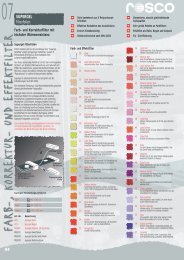Lighting the Acting Areas - AudioMaster
Lighting the Acting Areas - AudioMaster
Lighting the Acting Areas - AudioMaster
You also want an ePaper? Increase the reach of your titles
YUMPU automatically turns print PDFs into web optimized ePapers that Google loves.
Designers on Colour<br />
Colour has been an important component of stage lighting since <strong>the</strong> days of candles and silk. We reproduce here<br />
comments on <strong>the</strong> subject from <strong>the</strong> published works of some leading lighting designers:<br />
Gilbert V. Hemsley, Jr.<br />
“I think one of <strong>the</strong> greatest joys of lighting design is communicating to<br />
an audience how you, as a designer, feel about and understand<br />
color. Walking out from a darkened <strong>the</strong>atre on a sunny Spring<br />
afternoon and feeling my response to <strong>the</strong> warm sunshine, <strong>the</strong><br />
Supergel 64 of <strong>the</strong> blue sky and <strong>the</strong> light green shadows of <strong>the</strong> new<br />
leaves makes my head spin with <strong>the</strong> realization that I can translate my<br />
color excitement to a production of ‘You Can’t Take It With You’. I<br />
can make an audience see and feel <strong>the</strong> excitement of a beautiful<br />
Spring afternoon when <strong>the</strong> curtain goes up in a darkened <strong>the</strong>atre.<br />
It may sound strange, but I carry a color swatchbook around in my<br />
head. As I see, feel, and respond to color and color combinations in<br />
<strong>the</strong> real world, I make mental notes of <strong>the</strong> colors I see and my<br />
responses to <strong>the</strong>m. I have a storehouse of emotional and rational<br />
responses and <strong>the</strong> colours that go with <strong>the</strong>m.<br />
In learning to be artists as lighting designers it is exhilarating to have<br />
a full personal response to color and color combinations in <strong>the</strong> real<br />
world and <strong>the</strong>n communicate <strong>the</strong>m to <strong>the</strong> real audiences of <strong>the</strong> <strong>the</strong>atre<br />
world."<br />
Francis Reid<br />
“My filter philosophy is simple. Colour can support and enhance <strong>the</strong><br />
work of actors, <strong>the</strong>ir clo<strong>the</strong>s and <strong>the</strong>ir scenic environment. When<br />
using filters, I may be removing some parts of <strong>the</strong> light but I am<br />
enhancing those that remain. I am aware that my audience, like<br />
myself, watch a lot of television so I must light to produce much more<br />
natural skin tones that I did thirty years ago. My colour ambience<br />
now has to surround <strong>the</strong> actor, tinting <strong>the</strong> environment, particularly <strong>the</strong><br />
airspace that <strong>the</strong> light passes through and <strong>the</strong> floor that it hits, while<br />
leaving <strong>the</strong> face and <strong>the</strong> costume as naturally coloured as possible -<br />
usually with Supergel 351. The practicalities of my approach are<br />
based simply upon <strong>the</strong> realisation that if I take <strong>the</strong> spectrum apart with<br />
filters, <strong>the</strong>n I can put that spectrum toge<strong>the</strong>r again by superimposing<br />
<strong>the</strong> filtered light beams. It is a gloriously unscientific process; not so<br />
much a rule-of-thumb as one of crossed fingers. And trusting my<br />
eyes.”<br />
Nigel Morgan<br />
“Out of all <strong>the</strong> parameters that <strong>the</strong> lighting designer sets when<br />
composing a composition, colour is <strong>the</strong> one most likely to get an<br />
immediate reaction from o<strong>the</strong>r members of <strong>the</strong> team. Given <strong>the</strong><br />
number of colour tones available, making <strong>the</strong> right choice isn’t always<br />
easy. That is why it is so important to experiment with lighting models,<br />
colour and fabric samples - and to share <strong>the</strong> discoveries you make<br />
with <strong>the</strong> rest of <strong>the</strong> creative team. Where else can you ‘rehearse’<br />
your lighting? In <strong>the</strong> model room you can find just <strong>the</strong> right tone,<br />
combined with <strong>the</strong> right intensity and source position, mix <strong>the</strong> right<br />
blend with o<strong>the</strong>r lights.”<br />
Richard Pilbrow<br />
“Fractured white light reveals colour. Part of <strong>the</strong> magic of stage<br />
lighting is taking complex multi-directional palettes of colour and<br />
re-combining <strong>the</strong>m into lucid, dramatic light for <strong>the</strong> stage.<br />
When I began lighting, only about fifty shades of Cinemoid were<br />
available. I often used <strong>the</strong>m two or three to a frame seeking new<br />
possibilities. Then I discovered <strong>the</strong> Rosco range and first brought this<br />
wonderful range to Britain. Now <strong>the</strong> possibilities are almost limitless.<br />
Colour brings life, texture and vibrancy to <strong>the</strong> stage. I love it!”<br />
Jennifer Tipton<br />
“The use of color is key to a lighting designer’s craft. I am constantly<br />
reminded as I watch <strong>the</strong> light change from <strong>the</strong> brilliance of a sunny<br />
morning to <strong>the</strong> early dusk of a winter afternoon, how much color <strong>the</strong>re<br />
is in natural so-called ‘white light’ and how much variety in color can<br />
be made by simply brightening and dimming a light. It is a<br />
wonderfully juicy thing to ‘paint’ with colored light – to use light<br />
expressionistically – to make <strong>the</strong> audience feel <strong>the</strong> scream, live <strong>the</strong><br />
blues or dance with danger. Or to paint with colored light can<br />
simply be about <strong>the</strong> beauty of juxtaposing one color next to ano<strong>the</strong>r<br />
and being able to change it from one moment to <strong>the</strong> next for purely<br />
compositional reasons. But I am also madly in love with <strong>the</strong> ravishing<br />
light that can be made from <strong>the</strong> use of <strong>the</strong> very limited range of colors<br />
– lavender, blue and clear – that makes <strong>the</strong> skin glow no matter what<br />
color <strong>the</strong> skin may be.”<br />
David Belasco<br />
“The greatest part of my success in <strong>the</strong> <strong>the</strong>atre I attribute to my feeling<br />
for colors, translated into effects of light.” (1919)<br />
The late Gilbert V. Hemsley, Jr. said that<br />
“I carry a color swatchbook<br />
around in my head ”<br />
An example of his brilliant application of colour is shown in <strong>the</strong> photo on <strong>the</strong> left.<br />
| 3






